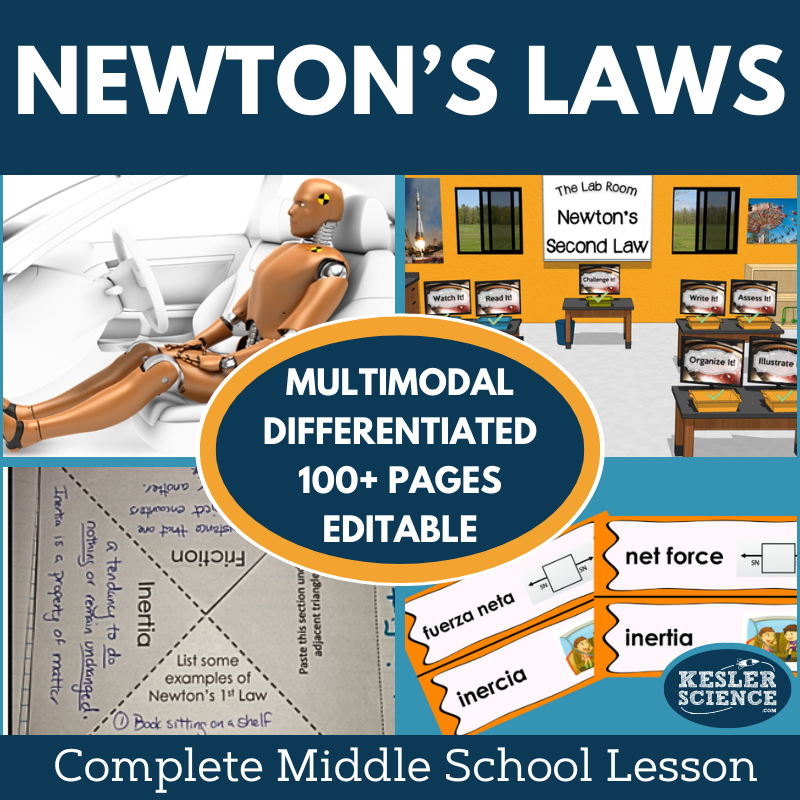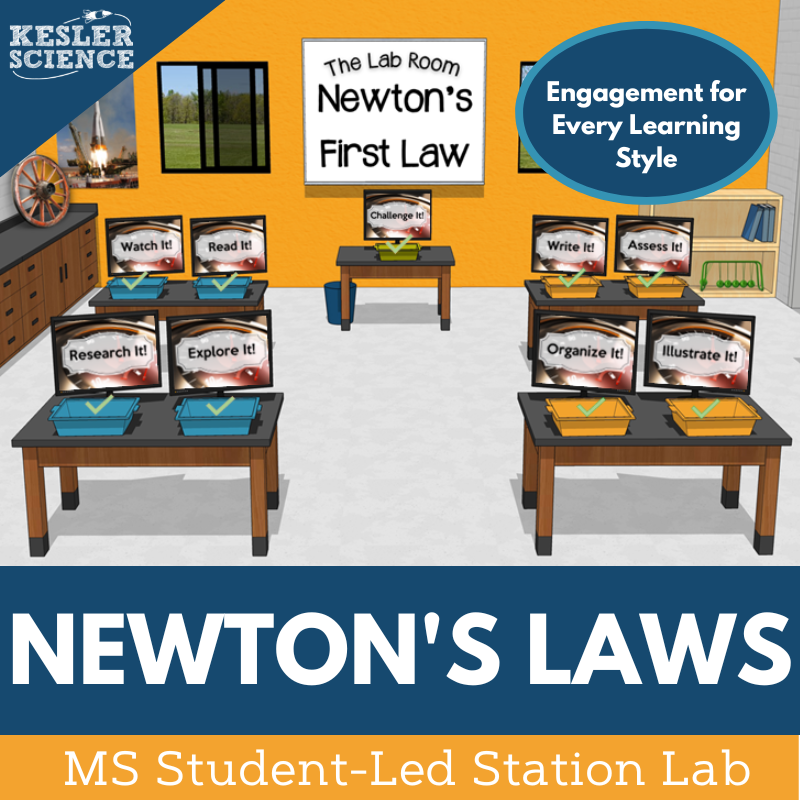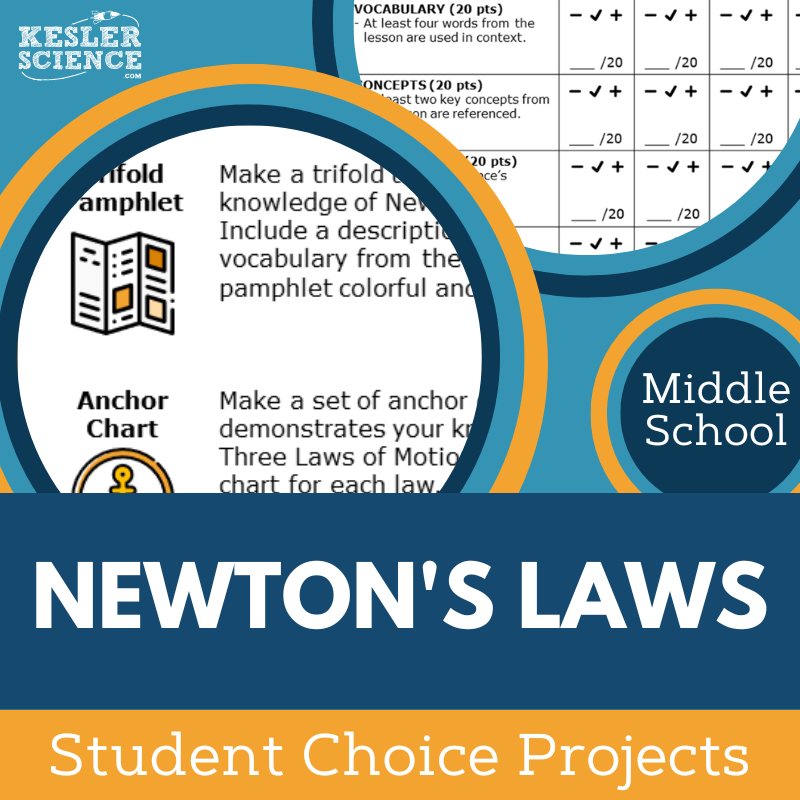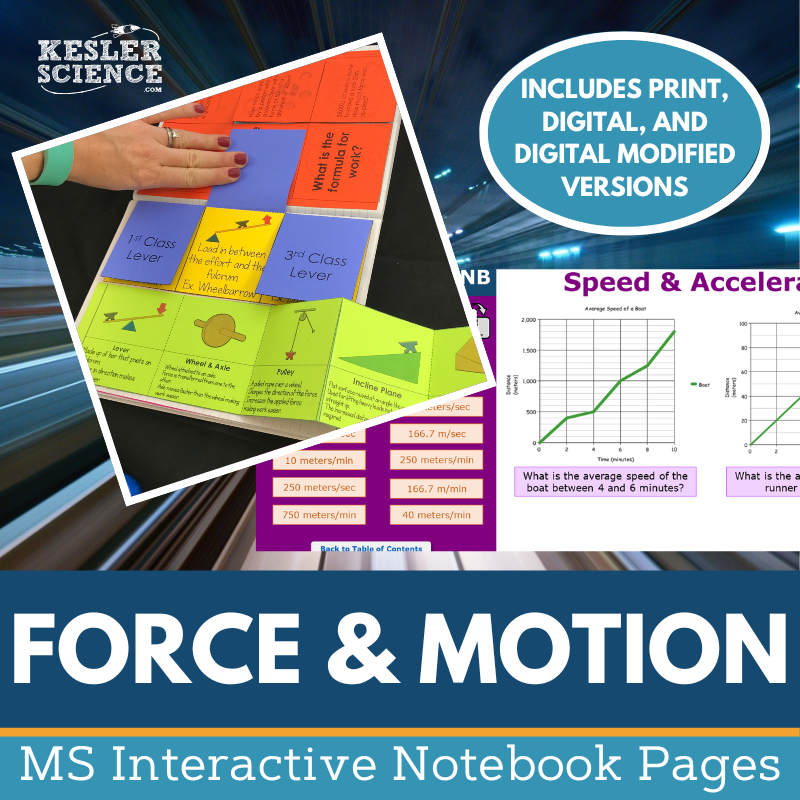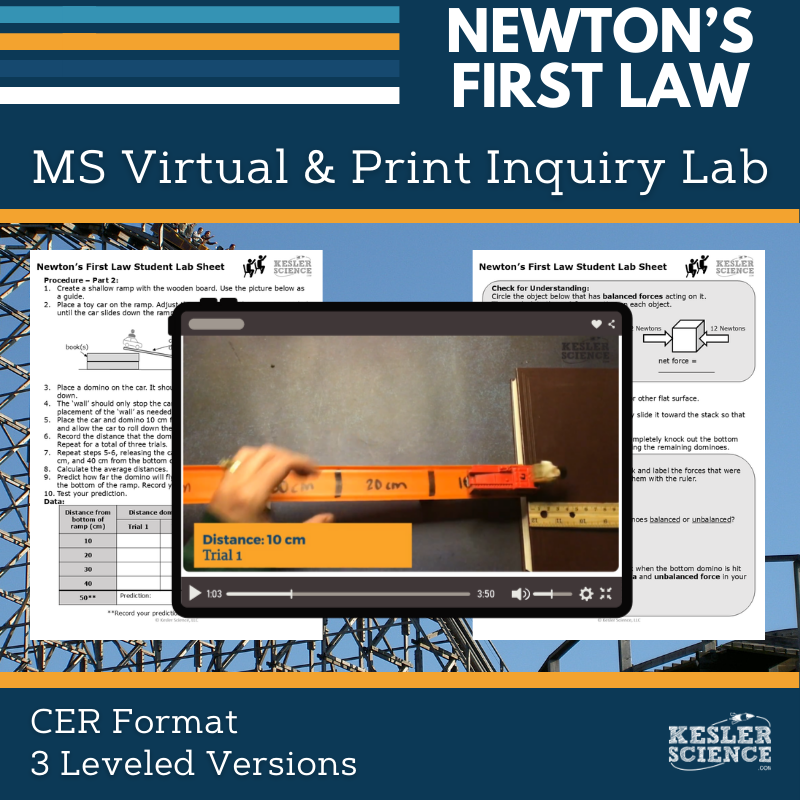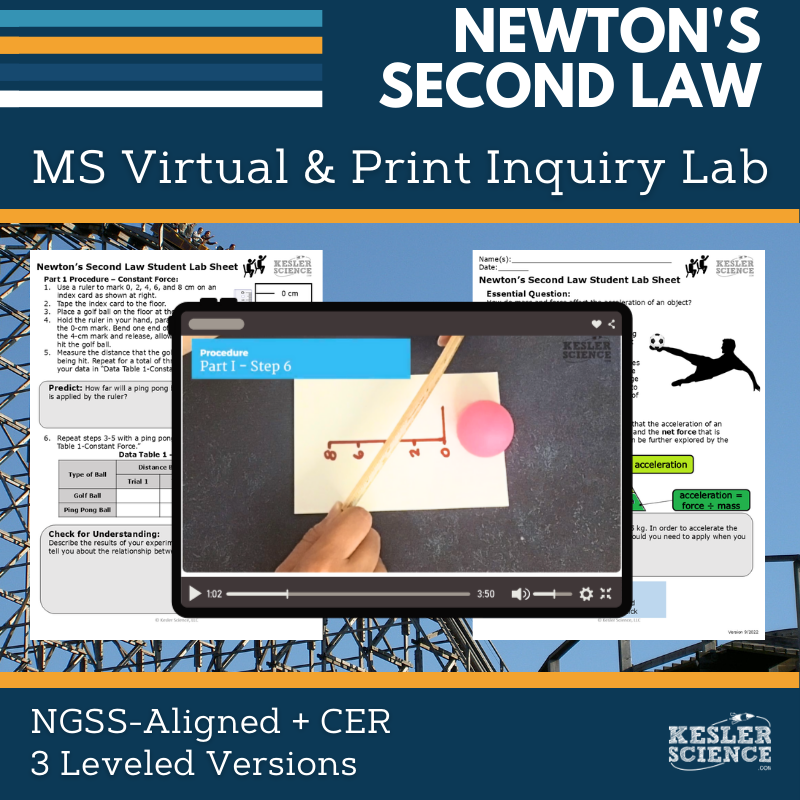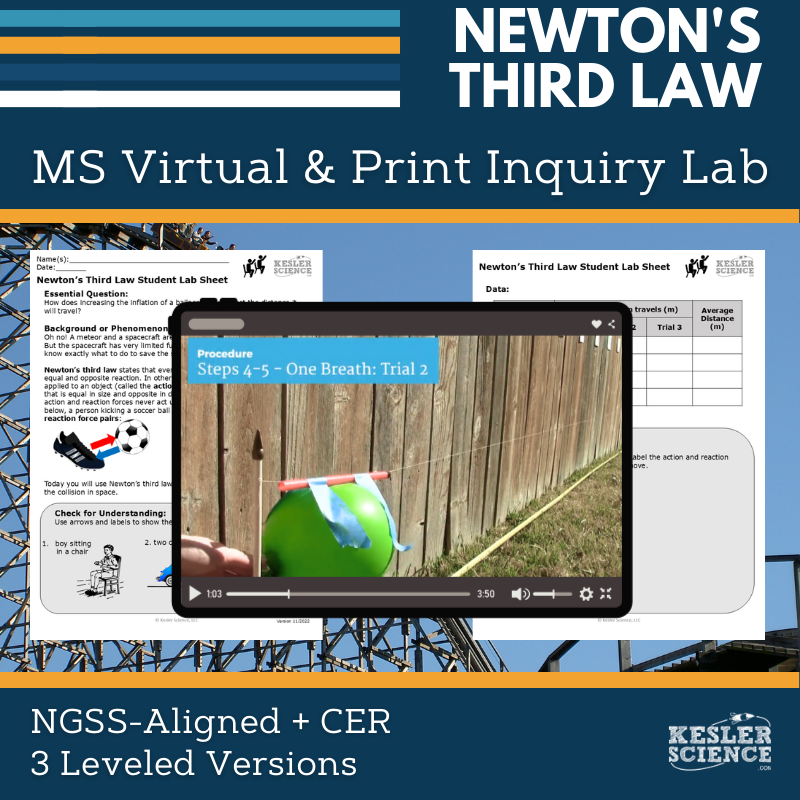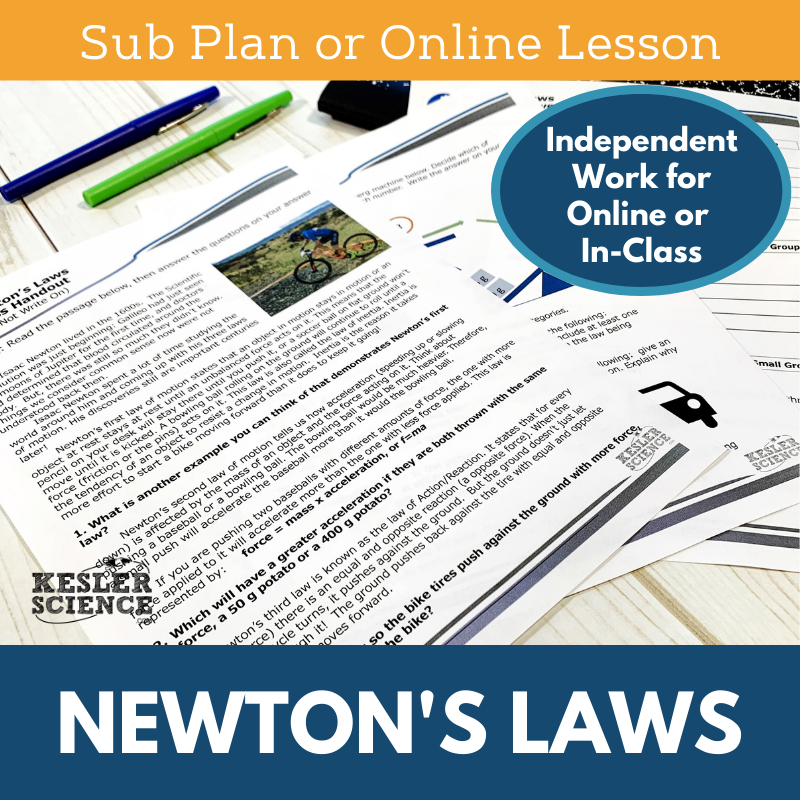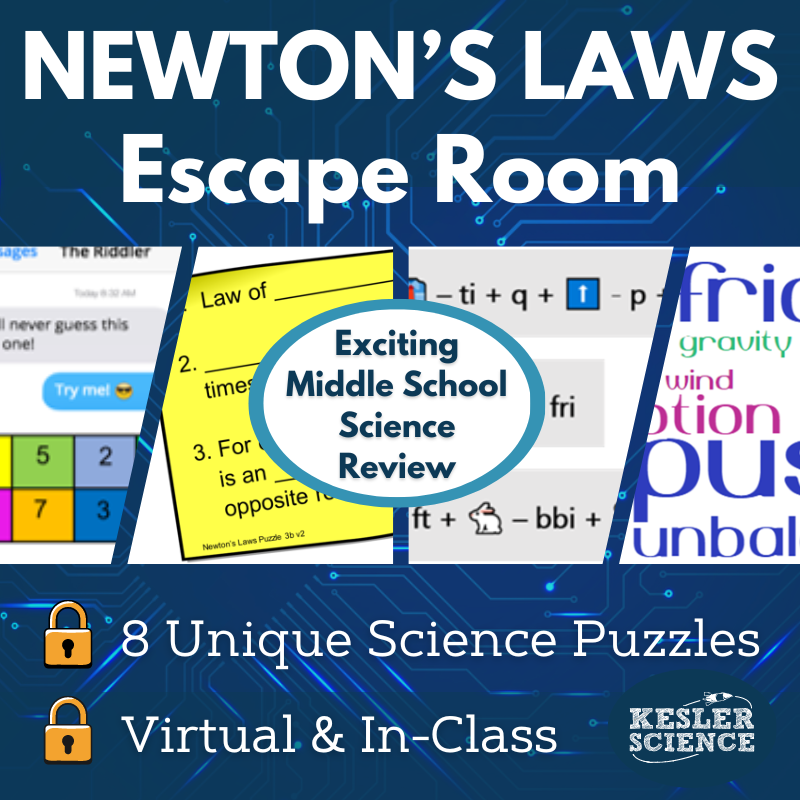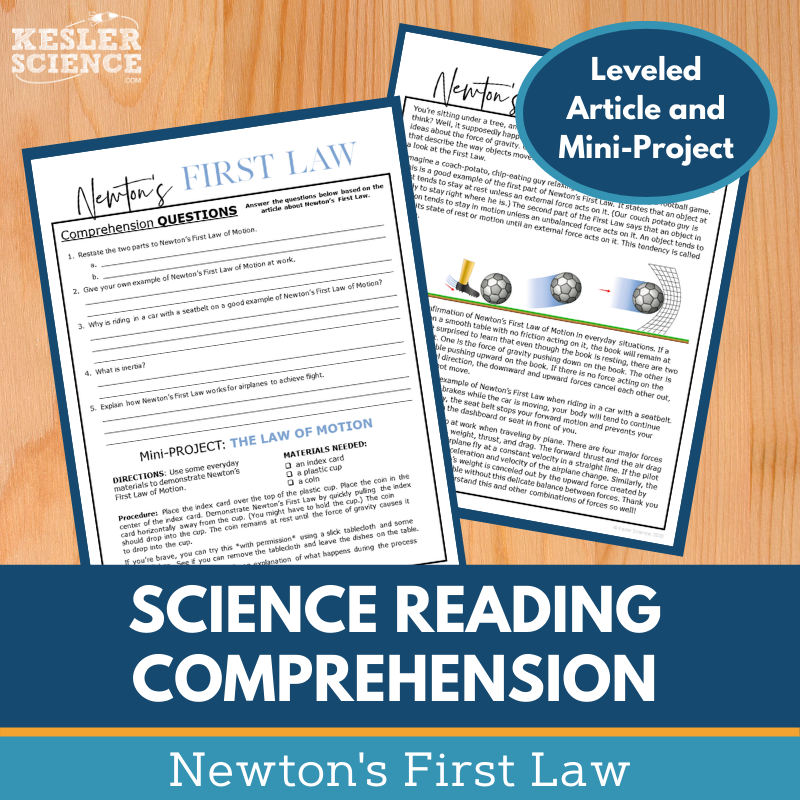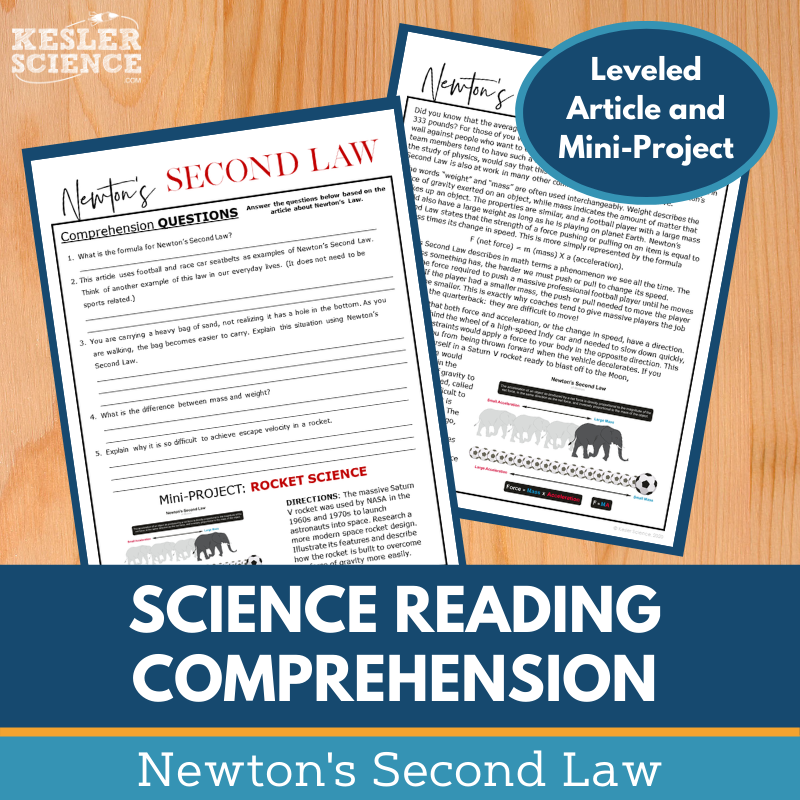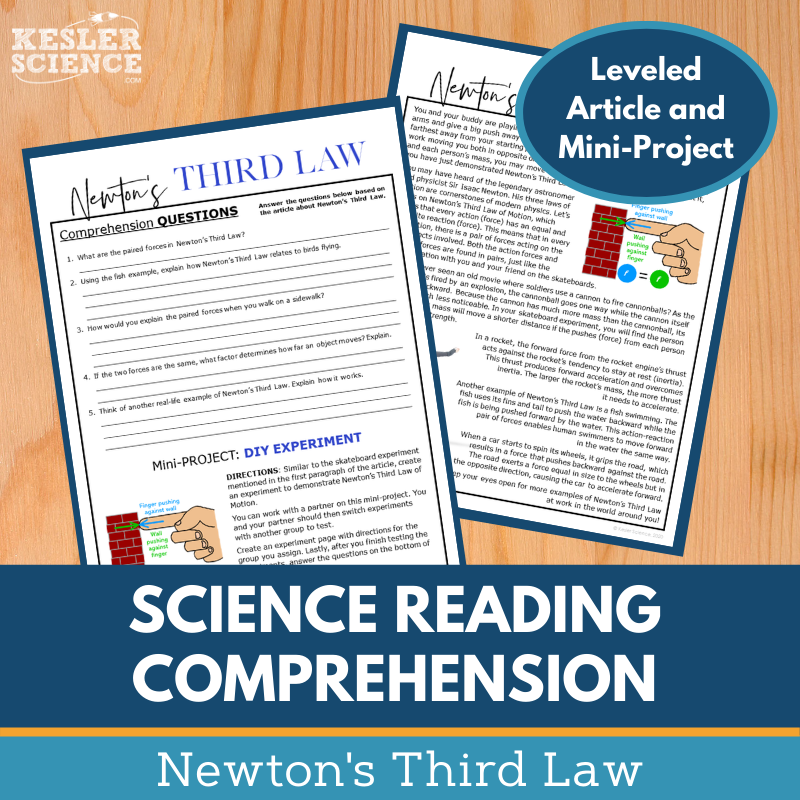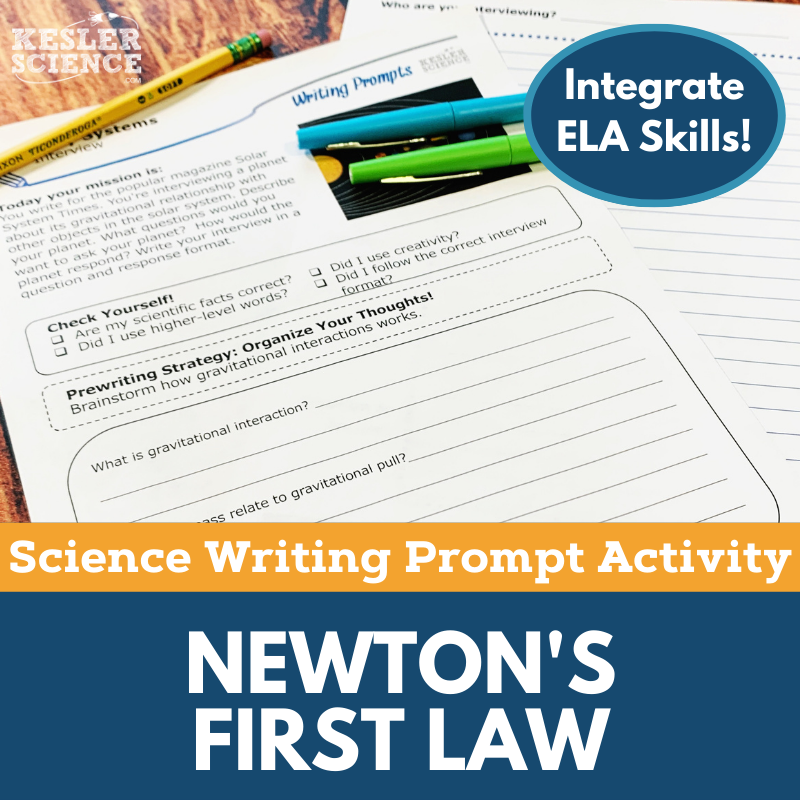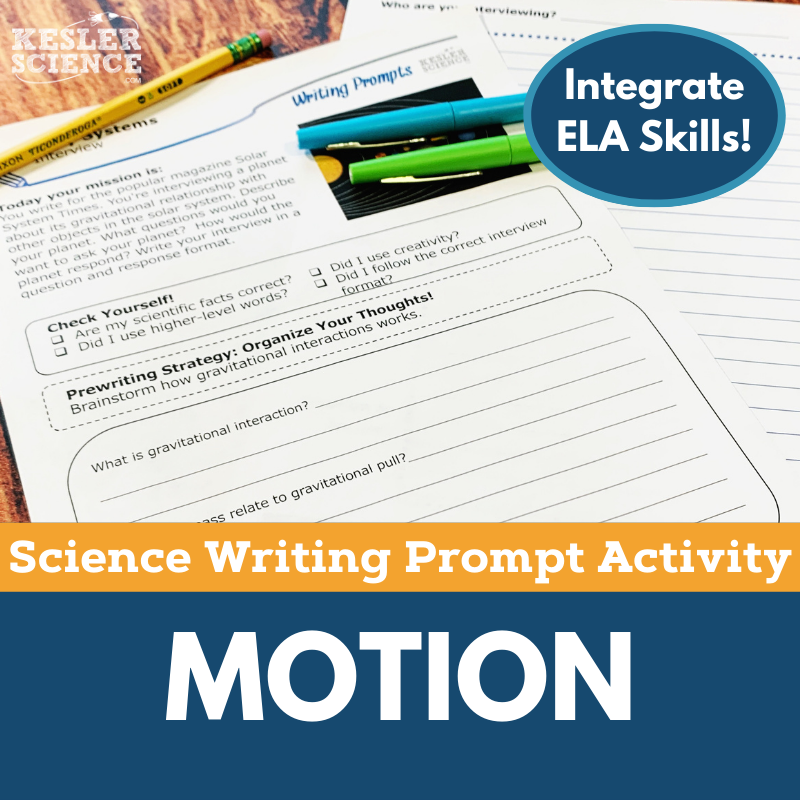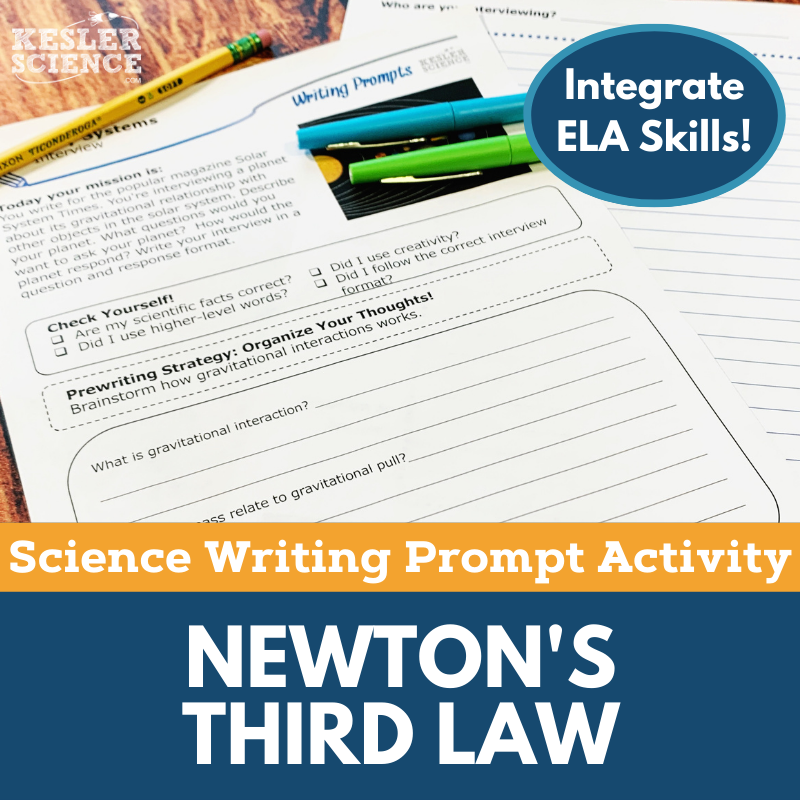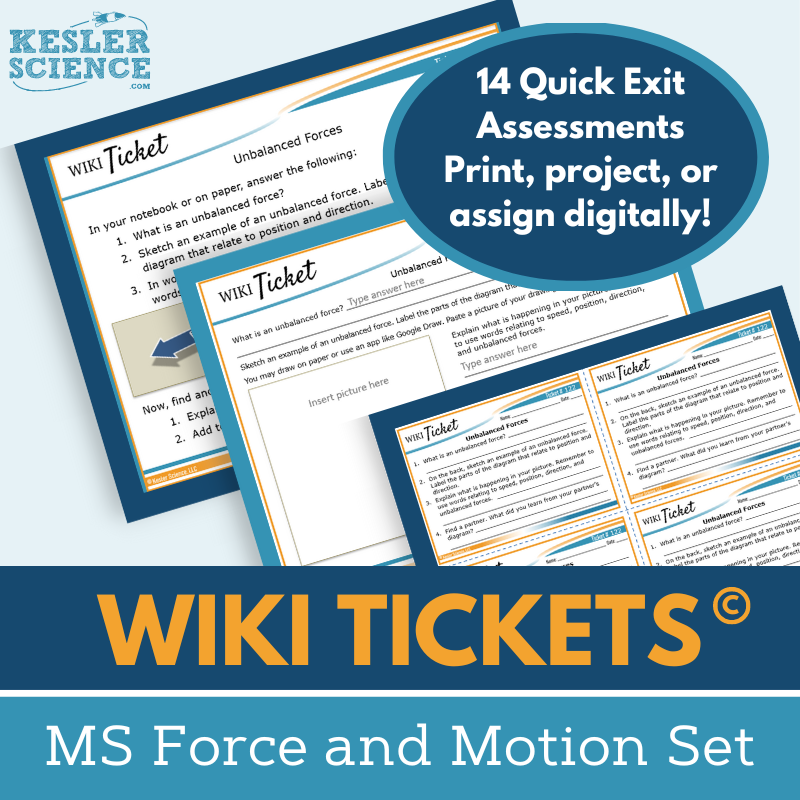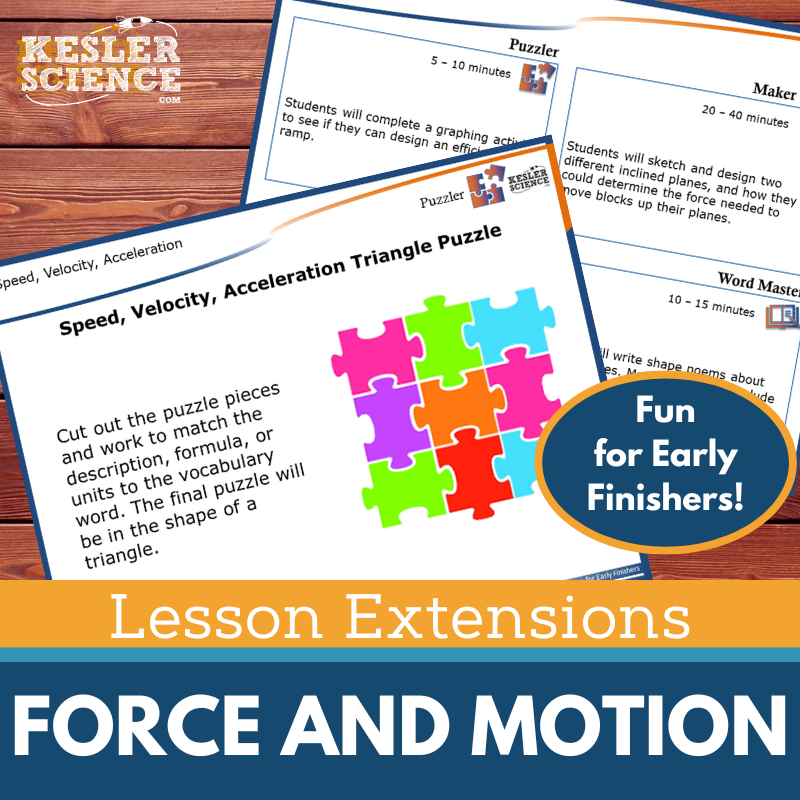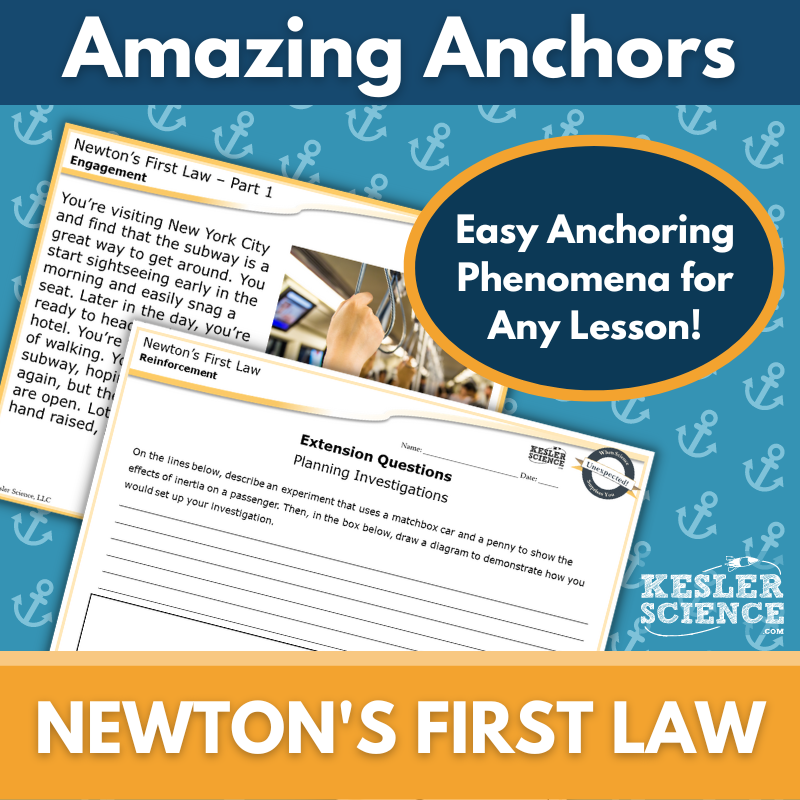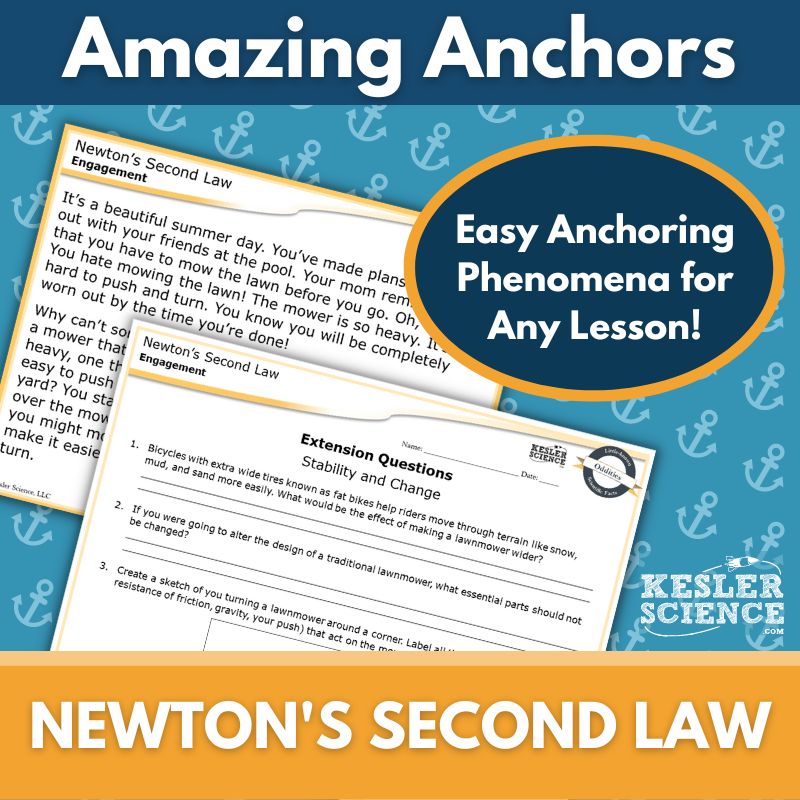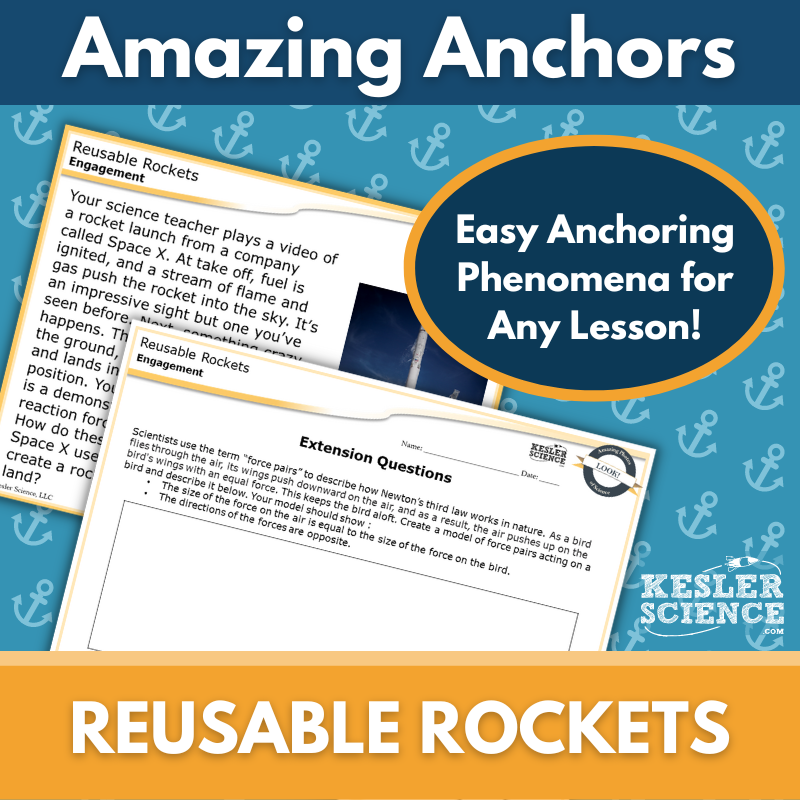Newton's Laws Activities for Middle School Science
The Kesler Science Newton’s Laws resources offer a comprehensive, student-centered approach to teaching forces and motion, with flexible, differentiated materials for both in-person and digital classrooms. The resources below will give students a comprehensive understanding of Newton's laws. All of the following materials are also included in the Kesler Science Membership.
The Kesler Science Newton’s Laws 5E Lesson is a comprehensive, student-centered unit designed for middle school classrooms. This fully editable resource includes PowerPoints, interactive notebooks, worksheets, and assessments in both English and Spanish. Students explore how Newton’s laws relate to real-world scenarios like sports, amusement parks, tectonic forces, and rockets. The multiday content is low-prep, highly flexible for digital or print use, and offers differentiated instruction to support all learners.
Following the 5E Model, the unit begins with engaging objectives and vocabulary resources in English and Spanish, plus discussion prompts and misconceptions. During exploration, students rotate through nine multimodal stations—including hands-on demos, readings, videos, research tasks, and interactive activities—to absorb and demonstrate their understanding of Newton’s laws. Output tasks like writing, drawing, sorting, and assessments ensure a variety of learning styles are supported, while the “Challenge It!” station offers extension opportunities.
The explanation phase uses editable presentations and structured notes to deepen understanding, followed by student-choice projects for elaboration. The unit concludes with STAAR 2.0-aligned assessments in multiple formats. Whether used in-person or virtually, this complete lesson supports rigorous and engaging science instruction across learning environments.
The Kesler Science Newton’s Laws 5E Lesson is a comprehensive, student-centered unit designed for middle school classrooms. This fully editable resource includes PowerPoints, interactive notebooks, worksheets, and assessments in both English and Spanish. Students explore how Newton’s laws relate to real-world scenarios like sports, amusement parks, tectonic forces, and rockets. The multiday content is low-prep, highly flexible for digital or print use, and offers differentiated instruction to support all learners.
Following the 5E Model, the unit begins with engaging objectives and vocabulary resources in English and Spanish, plus discussion prompts and misconceptions. During exploration, students rotate through nine multimodal stations—including hands-on demos, readings, videos, research tasks, and interactive activities—to absorb and demonstrate their understanding of Newton’s laws. Output tasks like writing, drawing, sorting, and assessments ensure a variety of learning styles are supported, while the “Challenge It!” station offers extension opportunities.
The explanation phase uses editable presentations and structured notes to deepen understanding, followed by student-choice projects for elaboration. The unit concludes with STAAR 2.0-aligned assessments in multiple formats. Whether used in-person or virtually, this complete lesson supports rigorous and engaging science instruction across learning environments.
The Kesler Science modular, student-led Newton's Laws Station Lab offers middle school students a dynamic way to engage with forces and motion concepts while allowing them to direct their own learning. This student-centered approach gives teachers more time to facilitate rather than lead, with eight differentiated stations and a ninth challenge station for early finishers. Each station includes comprehensive resources like signage, literature, and task cards, allowing students to work independently or in small groups with minimal prep time.
The stations are divided into Input and Output activities. Input stations such as "Explore It!" and "Research It!" provide hands-on and digital opportunities for students to learn about Newton’s laws. Output stations like "Organize It!" and "Illustrate It!" let students demonstrate their understanding through physical tasks or drawings. A bonus "Challenge It!" station offers extension activities for advanced students.
The station lab is flexible for both in-person and virtual learning environments, using basic classroom materials or digital tools. Differentiated passages and bilingual content ensure accessibility for all learners.
The Kesler Science modular, student-led Newton's Laws Station Lab offers middle school students a dynamic way to engage with forces and motion concepts while allowing them to direct their own learning. This student-centered approach gives teachers more time to facilitate rather than lead, with eight differentiated stations and a ninth challenge station for early finishers. Each station includes comprehensive resources like signage, literature, and task cards, allowing students to work independently or in small groups with minimal prep time.
The stations are divided into Input and Output activities. Input stations such as "Explore It!" and "Research It!" provide hands-on and digital opportunities for students to learn about Newton’s laws. Output stations like "Organize It!" and "Illustrate It!" let students demonstrate their understanding through physical tasks or drawings. A bonus "Challenge It!" station offers extension activities for advanced students.
The station lab is flexible for both in-person and virtual learning environments, using basic classroom materials or digital tools. Differentiated passages and bilingual content ensure accessibility for all learners.
The Kesler Science Student Choice Projects for Newton’s Laws empower middle school students to select a project that suits their learning style. With nine distinct project options and a "design your own" choice, students can demonstrate their understanding in personalized, creative ways. Teachers can adjust the provided grading rubric to meet their specific assessment needs. This flexibility allows students to showcase their knowledge in diverse formats, whether digitally or with basic classroom materials.
Differentiated for varying student needs, the lesson includes two project page versions. One version offers three options tailored for students requiring remediation, while the other allows for more challenging combinations for advanced learners. The editable rubric assesses vocabulary, concepts, presentation, clarity, and accuracy, providing a thorough evaluation.
Designed with accessible materials in mind, the projects require only basic supplies like paper, markers, and scissors, though crafting materials may be useful for building models. Many projects can be completed digitally, offering flexibility in the approach.
The Kesler Science Student Choice Projects for Newton’s Laws empower middle school students to select a project that suits their learning style. With nine distinct project options and a "design your own" choice, students can demonstrate their understanding in personalized, creative ways. Teachers can adjust the provided grading rubric to meet their specific assessment needs. This flexibility allows students to showcase their knowledge in diverse formats, whether digitally or with basic classroom materials.
Differentiated for varying student needs, the lesson includes two project page versions. One version offers three options tailored for students requiring remediation, while the other allows for more challenging combinations for advanced learners. The editable rubric assesses vocabulary, concepts, presentation, clarity, and accuracy, providing a thorough evaluation.
Designed with accessible materials in mind, the projects require only basic supplies like paper, markers, and scissors, though crafting materials may be useful for building models. Many projects can be completed digitally, offering flexibility in the approach.
The Kesler Science Force and Motion Interactive Notebook offers a dynamic way to engage students in learning key physics concepts. This resource includes both print and digital versions, making it adaptable for any classroom setting, including traditional, 1:1 environments, and distance learning.
The notebook covers essential topics such as speed, velocity, acceleration, Newton’s laws, simple machines, and motion graphing. The digital version includes a PowerPoint file that can be uploaded to platforms like Google Slides, MS Teams, or Canvas. It also features reflection pages, space for note-taking, and a modified version for students with accommodations.
For in-person learning, the paper version provides blank and pre-filled templates with color photos for easy use. Whether online or in the classroom, the Force and Motion Interactive Notebook is a versatile tool that helps students actively engage with and understand the material.
The Kesler Science Force and Motion Interactive Notebook offers a dynamic way to engage students in learning key physics concepts. This resource includes both print and digital versions, making it adaptable for any classroom setting, including traditional, 1:1 environments, and distance learning.
The notebook covers essential topics such as speed, velocity, acceleration, Newton’s laws, simple machines, and motion graphing. The digital version includes a PowerPoint file that can be uploaded to platforms like Google Slides, MS Teams, or Canvas. It also features reflection pages, space for note-taking, and a modified version for students with accommodations.
For in-person learning, the paper version provides blank and pre-filled templates with color photos for easy use. Whether online or in the classroom, the Force and Motion Interactive Notebook is a versatile tool that helps students actively engage with and understand the material.
The Newton's First Law Inquiry Lab engages students in exploring Newton’s first law using hands-on materials or an interactive virtual format. In this two-part investigation, students use a ruler to knock the bottom domino from a stack and then slide stacked dominoes down a ramp into a wall to observe how inertia affects the motion of the top domino. The digital version includes a video demonstration and simulations for students without access to materials.
The lab includes built-in differentiation with three versions to support all learners. The Modified version provides structured support with simplified tasks and guided questions. The Dependent version includes a balance of directions and inquiry, while the Independent version encourages advanced students to take full ownership of the lab process.
Both the print and digital formats include comprehension questions, Claim-Evidence-Reasoning (C.E.R.) prompts, and reflection components. Editable files, teacher guides, answer keys, and flexible compatibility with platforms like Google Slides make this resource easy to implement in any classroom setting.
The Newton's First Law Inquiry Lab engages students in exploring Newton’s first law using hands-on materials or an interactive virtual format. In this two-part investigation, students use a ruler to knock the bottom domino from a stack and then slide stacked dominoes down a ramp into a wall to observe how inertia affects the motion of the top domino. The digital version includes a video demonstration and simulations for students without access to materials.
The lab includes built-in differentiation with three versions to support all learners. The Modified version provides structured support with simplified tasks and guided questions. The Dependent version includes a balance of directions and inquiry, while the Independent version encourages advanced students to take full ownership of the lab process.
Both the print and digital formats include comprehension questions, Claim-Evidence-Reasoning (C.E.R.) prompts, and reflection components. Editable files, teacher guides, answer keys, and flexible compatibility with platforms like Google Slides make this resource easy to implement in any classroom setting.
The Newton's Second Law Inquiry Lab aligns with NGSS MS-PS2-2 and helps students explore how force and mass affect acceleration. Students engage with either a virtual demonstration and video or a printed, hands-on experiment that includes comprehension questions, Claim-Evidence-Reasoning (C.E.R.) prompts, and reflection activities. The investigation involves applying varying amounts of force to a golf ball to examine force and acceleration, and then applying the same force to a golf ball and a ping pong ball to compare the effect of mass on acceleration.
This lab offers built-in differentiation through three levels: dependent (on-level learners), modified (for students needing support), and independent (for advanced learners). Each level includes tailored procedures and questions to promote inquiry and accommodate different learning needs. Whether digital or print, the materials are editable, allowing teachers to adapt the content for their classrooms.
The digital lab includes a pre-recorded video of the entire procedure and interactive components for students without access to physical materials. Print versions require standard classroom supplies such as a golf ball, ping pong ball, ruler, tape, and meter stick. Answer keys, editable formats, and detailed teacher resource pages help simplify implementation and provide a flexible, student-centered experience.
The Newton's Second Law Inquiry Lab aligns with NGSS MS-PS2-2 and helps students explore how force and mass affect acceleration. Students engage with either a virtual demonstration and video or a printed, hands-on experiment that includes comprehension questions, Claim-Evidence-Reasoning (C.E.R.) prompts, and reflection activities. The investigation involves applying varying amounts of force to a golf ball to examine force and acceleration, and then applying the same force to a golf ball and a ping pong ball to compare the effect of mass on acceleration.
This lab offers built-in differentiation through three levels: dependent (on-level learners), modified (for students needing support), and independent (for advanced learners). Each level includes tailored procedures and questions to promote inquiry and accommodate different learning needs. Whether digital or print, the materials are editable, allowing teachers to adapt the content for their classrooms.
The digital lab includes a pre-recorded video of the entire procedure and interactive components for students without access to physical materials. Print versions require standard classroom supplies such as a golf ball, ping pong ball, ruler, tape, and meter stick. Answer keys, editable formats, and detailed teacher resource pages help simplify implementation and provide a flexible, student-centered experience.
The Newton's Third Law Inquiry Lab aligns with NGSS MS PS2-1 and engages students in applying Newton’s Third Law by designing and testing balloon rockets. Students explore how the amount of air in a balloon affects how far it travels along a string, using multiple trials to gather evidence and draw conclusions.
This lab includes three differentiated versions—Dependent, Modified, and Independent—to meet a range of learning needs. Each version guides students through the scientific process with comprehension questions, Claim-Evidence-Reasoning (C.E.R.) prompts, and a reflection section. Teachers can choose between a fully virtual experience, featuring a step-by-step video demonstration, or a hands-on printed version.
Standard classroom supplies like string, straws, tape, and balloons are used in the print format, while the digital version offers interactive activities with no materials required. Editable files are compatible with Google Slides and include teacher resources, answer keys, and customizable content for maximum flexibility.
The Newton's Third Law Inquiry Lab aligns with NGSS MS PS2-1 and engages students in applying Newton’s Third Law by designing and testing balloon rockets. Students explore how the amount of air in a balloon affects how far it travels along a string, using multiple trials to gather evidence and draw conclusions.
This lab includes three differentiated versions—Dependent, Modified, and Independent—to meet a range of learning needs. Each version guides students through the scientific process with comprehension questions, Claim-Evidence-Reasoning (C.E.R.) prompts, and a reflection section. Teachers can choose between a fully virtual experience, featuring a step-by-step video demonstration, or a hands-on printed version.
Standard classroom supplies like string, straws, tape, and balloons are used in the print format, while the digital version offers interactive activities with no materials required. Editable files are compatible with Google Slides and include teacher resources, answer keys, and customizable content for maximum flexibility.
The Kesler Science Newton's Laws Sub Plan provides a comprehensive lesson on Newton’s laws, including a warm-up puzzle, reading passage, and independent activity. Students match scenarios to the correct law, analyze a diagram, and explain its relation to Newton’s laws. Extension activities for early finishers allow students to explore concepts further, such as sketching a Rube Goldberg machine or creating real-life scenarios for each law.
This sub plan is designed for both in-person and distance learning environments. It includes detailed instructions for substitutes, a Google Form for digital responses, and editable handouts for easy customization. The lesson also features behavior checkpoints, assessments, and engaging activities to ensure a smooth class experience.
The plan is versatile, perfect for substitutes, remote learning, or at-home assignments. With everything from teacher directions to student PDFs and answer keys, it simplifies lesson delivery and keeps students engaged while you’re away.
The Kesler Science Newton's Laws Sub Plan provides a comprehensive lesson on Newton’s laws, including a warm-up puzzle, reading passage, and independent activity. Students match scenarios to the correct law, analyze a diagram, and explain its relation to Newton’s laws. Extension activities for early finishers allow students to explore concepts further, such as sketching a Rube Goldberg machine or creating real-life scenarios for each law.
This sub plan is designed for both in-person and distance learning environments. It includes detailed instructions for substitutes, a Google Form for digital responses, and editable handouts for easy customization. The lesson also features behavior checkpoints, assessments, and engaging activities to ensure a smooth class experience.
The plan is versatile, perfect for substitutes, remote learning, or at-home assignments. With everything from teacher directions to student PDFs and answer keys, it simplifies lesson delivery and keeps students engaged while you’re away.
The Kesler Science Newton's Laws Escape Room offers a fun, interactive way for students to apply their knowledge of Newton’s laws through eight independent puzzles. Teachers can choose which puzzles to use and their order, making the activity adaptable for varying class lengths. The puzzles can be set up in simple manila envelopes or with locks for a more immersive experience.
This escape room is versatile, with both physical and digital options for use. The digital version can be assigned via PowerPoint or Google Slides, while the print version allows families to participate from home. All materials, including teacher directions, a detailed answer key, and reward templates, are provided to ensure smooth implementation.
For added excitement, a video challenge sets the mood for the activity, and students can celebrate their success with unique signs and prizes. With these resources, students will enjoy a memorable and educational escape room experience that reinforces key science concepts.
The Kesler Science Newton's Laws Escape Room offers a fun, interactive way for students to apply their knowledge of Newton’s laws through eight independent puzzles. Teachers can choose which puzzles to use and their order, making the activity adaptable for varying class lengths. The puzzles can be set up in simple manila envelopes or with locks for a more immersive experience.
This escape room is versatile, with both physical and digital options for use. The digital version can be assigned via PowerPoint or Google Slides, while the print version allows families to participate from home. All materials, including teacher directions, a detailed answer key, and reward templates, are provided to ensure smooth implementation.
For added excitement, a video challenge sets the mood for the activity, and students can celebrate their success with unique signs and prizes. With these resources, students will enjoy a memorable and educational escape room experience that reinforces key science concepts.
This Newton’s First Law Science Reading Comprehension Lesson helps students explore how motion is affected by balanced and unbalanced forces. Designed for middle school, the leveled nonfiction passage supports science literacy through engaging content and a hands-on activity. After reading the article, students answer comprehension questions and conduct a simple demonstration using everyday materials to reinforce Newton’s first law of motion.
The resource includes two leveled articles (Lexile 1100–1300), five to seven comprehension questions, and an interactive mini-project. A Cornell notes template is also provided, along with vibrant graphics that are easy to print. The activity is suitable for grades 6–8 and can be used for sub plans, ISS, extra credit, or whole-class instruction.
This flexible resource is ideal for in-person or virtual learning through platforms like Google Classroom, MS Teams, Schoology, or Canvas. Students can complete the reading and activities digitally or on paper, making it easy to integrate science literacy into your existing lesson plans while promoting classroom discussion and textual analysis.
This Newton’s First Law Science Reading Comprehension Lesson helps students explore how motion is affected by balanced and unbalanced forces. Designed for middle school, the leveled nonfiction passage supports science literacy through engaging content and a hands-on activity. After reading the article, students answer comprehension questions and conduct a simple demonstration using everyday materials to reinforce Newton’s first law of motion.
The resource includes two leveled articles (Lexile 1100–1300), five to seven comprehension questions, and an interactive mini-project. A Cornell notes template is also provided, along with vibrant graphics that are easy to print. The activity is suitable for grades 6–8 and can be used for sub plans, ISS, extra credit, or whole-class instruction.
This flexible resource is ideal for in-person or virtual learning through platforms like Google Classroom, MS Teams, Schoology, or Canvas. Students can complete the reading and activities digitally or on paper, making it easy to integrate science literacy into your existing lesson plans while promoting classroom discussion and textual analysis.
This Newton’s Second Law Science Reading Comprehension Lesson helps students understand how force, mass, and acceleration interact by exploring modern space rocket design. Middle school students read a nonfiction article about Newton’s second law, answer comprehension questions, and complete a mini-project where they research and illustrate a rocket, explaining how it is engineered to overcome gravity.
The resource includes two leveled reading passages (Lexile 1100–1300), five to seven comprehension questions, and a hands-on research and illustration activity. A Cornell notes template is provided to support note-taking, and the reading is visually engaging yet printer-friendly. This lesson is ideal for students in grades 6–8 and can be used in a variety of classroom settings, including for sub plans or enrichment.
Digital and print-ready, this lesson integrates seamlessly into virtual platforms like Google Classroom, MS Teams, and Schoology. It supports science literacy and critical thinking, making it perfect for building textual analysis skills, sparking classroom discussions, and reinforcing key science concepts.
This Newton’s Second Law Science Reading Comprehension Lesson helps students understand how force, mass, and acceleration interact by exploring modern space rocket design. Middle school students read a nonfiction article about Newton’s second law, answer comprehension questions, and complete a mini-project where they research and illustrate a rocket, explaining how it is engineered to overcome gravity.
The resource includes two leveled reading passages (Lexile 1100–1300), five to seven comprehension questions, and a hands-on research and illustration activity. A Cornell notes template is provided to support note-taking, and the reading is visually engaging yet printer-friendly. This lesson is ideal for students in grades 6–8 and can be used in a variety of classroom settings, including for sub plans or enrichment.
Digital and print-ready, this lesson integrates seamlessly into virtual platforms like Google Classroom, MS Teams, and Schoology. It supports science literacy and critical thinking, making it perfect for building textual analysis skills, sparking classroom discussions, and reinforcing key science concepts.
This Newton’s Third Law Science Reading Comprehension Lesson immerses middle school students in the principle that every action has an equal and opposite reaction. Through a leveled nonfiction article, students explore real-world applications of Newton’s third law and solidify their understanding by designing and conducting a simple experiment that demonstrates this foundational concept in physics.
The resource includes two differentiated reading passages with Lexile levels between 1100 and 1300, along with five to seven comprehension questions and a hands-on mini-project. A Cornell notes template supports structured reading, while colorful, print-friendly visuals enhance student engagement. The materials are tailored for grades 6–8 and are suitable for both core instruction and flexible settings like sub plans, enrichment, or independent study.
Designed for seamless integration in both traditional and virtual classrooms, this lesson supports platforms such as Google Classroom, MS Teams, Schoology, and Canvas. Students can interact with the content directly within editable digital files. This resource fosters deeper conceptual understanding, promotes critical thinking, and enhances scientific literacy through purposeful reading and inquiry-based experimentation—all while strengthening students’ analytical and communication skills.
The Newton’s Third Law Science Reading Comprehension Lesson immerses middle school students in the principle that every action has an equal and opposite reaction. Through a leveled nonfiction article, students explore real-world applications of Newton’s third law and solidify their understanding by designing and conducting a simple experiment that demonstrates this foundational concept in physics.
The resource includes two differentiated reading passages with Lexile levels between 1100 and 1300, along with five to seven comprehension questions and a hands-on mini-project. A Cornell notes template supports structured reading, while colorful, print-friendly visuals enhance student engagement. The materials are tailored for grades 6–8 and are suitable for both core instruction and flexible settings like sub plans, enrichment, or independent study.
Designed for seamless integration in both traditional and virtual classrooms, this lesson supports platforms such as Google Classroom, MS Teams, Schoology, and Canvas. Students can interact with the content directly within editable digital files. This resource fosters deeper conceptual understanding, promotes critical thinking, and enhances scientific literacy through purposeful reading and inquiry-based experimentation—all while strengthening students’ analytical and communication skills.
The Newton’s First Law science writing activity engages middle school students in a creative commercial-writing exercise designed to deepen their understanding of motion and inertia. Aligned to TEKS and NGSS standards, this low-prep activity supports both in-person and virtual instruction, encouraging students to apply their physical science knowledge while building communication and reasoning skills.
This resource includes teacher directions with rubrics, project ideas, and answer guides, as well as multiple formatting options. Students can use full-sized or half-sheet handouts, and a digital version is available for seamless integration into Google Slides or PowerPoint. The included writing prompt, pre-writing strategy, and self-check tools help guide students through the creative process in a structured yet flexible format.
Ideal for cross-curricular connections, student choice projects, early finisher tasks, or TELPAS samples, this writing prompt also serves as a great tool for elaboration, extra credit, or make-up work. Designed for students with prior topic knowledge or access to research, it promotes engagement, creativity, and science literacy in any classroom setting.
The Newton’s First Law science writing activity engages middle school students in a creative commercial-writing exercise designed to deepen their understanding of motion and inertia. Aligned to TEKS and NGSS standards, this low-prep activity supports both in-person and virtual instruction, encouraging students to apply their physical science knowledge while building communication and reasoning skills.
This resource includes teacher directions with rubrics, project ideas, and answer guides, as well as multiple formatting options. Students can use full-sized or half-sheet handouts, and a digital version is available for seamless integration into Google Slides or PowerPoint. The included writing prompt, pre-writing strategy, and self-check tools help guide students through the creative process in a structured yet flexible format.
Ideal for cross-curricular connections, student choice projects, early finisher tasks, or TELPAS samples, this writing prompt also serves as a great tool for elaboration, extra credit, or make-up work. Designed for students with prior topic knowledge or access to research, it promotes engagement, creativity, and science literacy in any classroom setting.
The Motion Science Writing Activity engages middle school students in a creative news event report to demonstrate their understanding of how forces affect motion. Aligned with NGSS standards, this low-prep, student-centered resource encourages scientific reasoning and communication while supporting both in-person and virtual learning environments.
Students are guided through the writing process using full-sized and half-sheet handouts that include prompts, self-checks, and pre-writing strategies. The activity also includes teacher directions, rubrics, project ideas, and a digital version formatted for use in PowerPoint or Google Slides. These flexible materials allow for seamless integration into any classroom setup.
This writing prompt works well as a cross-curricular assignment, student choice project, or elaboration activity for early finishers. It is also ideal for use as a formative assessment, TELPAS sample, extra credit, or differentiation tool. Designed for students with prior knowledge or access to research, this engaging activity helps foster science literacy and creative expression.
The Motion Science Writing Activity engages middle school students in a creative news event report to demonstrate their understanding of how forces affect motion. Aligned with NGSS standards, this low-prep, student-centered resource encourages scientific reasoning and communication while supporting both in-person and virtual learning environments.
Students are guided through the writing process using full-sized and half-sheet handouts that include prompts, self-checks, and pre-writing strategies. The activity also includes teacher directions, rubrics, project ideas, and a digital version formatted for use in PowerPoint or Google Slides. These flexible materials allow for seamless integration into any classroom setup.
This writing prompt works well as a cross-curricular assignment, student choice project, or elaboration activity for early finishers. It is also ideal for use as a formative assessment, TELPAS sample, extra credit, or differentiation tool. Designed for students with prior knowledge or access to research, this engaging activity helps foster science literacy and creative expression.
The Newton’s Third Law science writing activity challenges middle school students to apply their understanding of motion and forces through a creative call to action writing prompt. Aligned with NGSS standards, this low-prep resource encourages students to design solutions involving colliding objects while reinforcing scientific reasoning in a fun and engaging format.
The activity includes full-sized and half-sheet handouts with writing prompts, pre-writing strategies, and self-check tools, along with detailed teacher directions, rubrics, and project ideas. A digital version is provided for use in PowerPoint or Google Slides, making the activity accessible for both in-person and remote learning environments.
Perfect for cross-curricular projects, early finisher tasks, or formative assessments, this writing prompt also serves well for extra credit, make-up work, or TELPAS samples. Designed for students with prior knowledge or research access, it promotes creativity, critical thinking, and science communication in any classroom setting.
The Newton’s Third Law science writing activity challenges middle school students to apply their understanding of motion and forces through a creative call to action writing prompt. Aligned with NGSS standards, this low-prep resource encourages students to design solutions involving colliding objects while reinforcing scientific reasoning in a fun and engaging format.
The activity includes full-sized and half-sheet handouts with writing prompts, pre-writing strategies, and self-check tools, along with detailed teacher directions, rubrics, and project ideas. A digital version is provided for use in PowerPoint or Google Slides, making the activity accessible for both in-person and remote learning environments.
Perfect for cross-curricular projects, early finisher tasks, or formative assessments, this writing prompt also serves well for extra credit, make-up work, or TELPAS samples. Designed for students with prior knowledge or research access, it promotes creativity, critical thinking, and science communication in any classroom setting.
The Kesler Science formative Force and Motion WIKI ticket assessments offer flexible, engaging options for checking student understanding. This set includes 14 assessments, each with five formats: a full-screen display version for projection, three handout sizes, and an interactive digital version (PPT or Google Slides). These assessments are aligned with NGSS and TEKS standards, covering topics like speed, unbalanced forces, and Newton’s laws.
WIKI Tickets provide a fun, interactive way to gauge students' progress, perfect for use as exit tickets, bellringers, or formative assessments during lessons. The resource works well in both traditional and virtual learning environments, allowing for easy adaptation to any classroom setting.
Each topic includes multiple formats, making it easy to implement in-person or online. Whether projected in class or completed digitally, these colorful assessments allow for continuous student engagement and real-time understanding checks, helping you monitor student progress throughout the unit.
The Kesler Science formative Force and Motion WIKI ticket assessments offer flexible, engaging options for checking student understanding. This set includes 14 assessments, each with five formats: a full-screen display version for projection, three handout sizes, and an interactive digital version (PPT or Google Slides). These assessments are aligned with NGSS and TEKS standards, covering topics like speed, unbalanced forces, and Newton’s laws.
WIKI Tickets provide a fun, interactive way to gauge students' progress, perfect for use as exit tickets, bellringers, or formative assessments during lessons. The resource works well in both traditional and virtual learning environments, allowing for easy adaptation to any classroom setting.
Each topic includes multiple formats, making it easy to implement in-person or online. Whether projected in class or completed digitally, these colorful assessments allow for continuous student engagement and real-time understanding checks, helping you monitor student progress throughout the unit.
The Kesler Science Force and Motion Lesson Extensions are designed to engage fast finishers with critical thinking and creativity. These activities offer a mix of rigor and fun, providing an ideal way to wrap up lessons or keep students occupied during testing. The activities help deepen understanding of force and motion while aligning with NGSS and TEKS standards.
Each extension includes four different types of activities: Puzzler, Maker Space, Tech Connection, and Word Master. These activities are student-driven, allowing for personalized learning experiences. Whether it’s solving puzzles, building models, exploring digital media, or expressing ideas through creative writing, each activity promotes critical thinking and hands-on engagement.
These extensions come with teacher directions, answer keys, and printable versions. The materials are flexible, allowing for use in both digital and in-person settings. Perfect for advanced learners or as supplementary activities, they provide a structured yet engaging way to dive deeper into topics like gravity, Newton’s laws, and speed.
The Kesler Science Force and Motion Lesson Extensions are designed to engage fast finishers with critical thinking and creativity. These activities offer a mix of rigor and fun, providing an ideal way to wrap up lessons or keep students occupied during testing. The activities help deepen understanding of force and motion while aligning with NGSS and TEKS standards.
Each extension includes four different types of activities: Puzzler, Maker Space, Tech Connection, and Word Master. These activities are student-driven, allowing for personalized learning experiences. Whether it’s solving puzzles, building models, exploring digital media, or expressing ideas through creative writing, each activity promotes critical thinking and hands-on engagement.
These extensions come with teacher directions, answer keys, and printable versions. The materials are flexible, allowing for use in both digital and in-person settings. Perfect for advanced learners or as supplementary activities, they provide a structured yet engaging way to dive deeper into topics like gravity, Newton’s laws, and speed.
This TEKS-aligned Amazing Anchors lesson introduces Newton’s first law through a real-world anchoring phenomenon centered on a New York City subway ride. The two-part resource includes an engaging introductory reading with comprehension and extension questions, followed by an explanatory text that breaks down the science behind Newton’s first law in an accessible way.
The lesson includes teacher directions with answer keys, editable digital and print formats, and both full-page and half-sheet handouts for flexible classroom use. It’s designed to support the Engagement and Elaborate phases of the 5E model, making it an ideal supplement to any middle school science lesson.
To support diverse learners, this resource features a modified version with differentiated language and sentence starters. It can be easily used in digital learning environments such as Google Classroom, offering an effective and engaging way to deepen student understanding of motion and inertia.
The TEKS-aligned Amazing Anchors lesson introduces Newton’s first law through a real-world anchoring phenomenon centered on a New York City subway ride. The two-part resource includes an engaging introductory reading with comprehension and extension questions, followed by an explanatory text that breaks down the science behind Newton’s first law in an accessible way.
The lesson includes teacher directions with answer keys, editable digital and print formats, and both full-page and half-sheet handouts for flexible classroom use. It’s designed to support the Engagement and Elaborate phases of the 5E model, making it an ideal supplement to any middle school science lesson.
To support diverse learners, this resource features a modified version with differentiated language and sentence starters. It can be easily used in digital learning environments such as Google Classroom, offering an effective and engaging way to deepen student understanding of motion and inertia.
This no-prep, NGSS- and TEKS-aligned Amazing Anchors lesson introduces Newton’s second law of motion through the relatable scenario of pushing a lawn mower. The two-part resource includes an introductory reading with comprehension and extension questions, followed by an explanatory text that clearly explains the relationship between force, mass, and acceleration.
Designed to supplement any middle school science lesson, this resource includes teacher directions with answer keys, editable digital and print formats, and both full-page and half-sheet handouts. It fits seamlessly into the Engagement and Elaborate phases of the 5E instructional model, helping students connect real-world experiences to scientific concepts.
To support differentiation, the lesson includes a modified version with simplified language and sentence starters. It’s available in formats ideal for both classroom and distance learning, making it an accessible and engaging tool for deepening student understanding of motion and force.
This no-prep, NGSS- and TEKS-aligned Amazing Anchors lesson introduces Newton’s second law of motion through the relatable scenario of pushing a lawn mower. The two-part resource includes an introductory reading with comprehension and extension questions, followed by an explanatory text that clearly explains the relationship between force, mass, and acceleration.
Designed to supplement any middle school science lesson, this resource includes teacher directions with answer keys, editable digital and print formats, and both full-page and half-sheet handouts. It fits seamlessly into the Engagement and Elaborate phases of the 5E instructional model, helping students connect real-world experiences to scientific concepts.
To support differentiation, the lesson includes a modified version with simplified language and sentence starters. It’s available in formats ideal for both classroom and distance learning, making it an accessible and engaging tool for deepening student understanding of motion and force.
This TEKS-aligned Amazing Anchors lesson introduces Newton’s laws through a real-world phenomenon centered on SpaceX. The two-part resource includes an engaging introductory reading with comprehension and extension questions, followed by an explanatory reading that breaks down the science behind Newton’s laws in an accessible way.
The lesson includes teacher directions with answer keys, editable digital and print formats, and full- and half-sheet student handouts. Designed to supplement any lesson, it fits perfectly into the Engagement and Elaborate phases of the 5E model, encouraging students to connect scientific concepts to real-world applications.
A modified version is included to support differentiation, featuring simplified language and sentence starters. The resource is fully compatible with distance learning platforms, making it a flexible, engaging way to reinforce students’ understanding of force and motion.
The TEKS-aligned Amazing Anchors lesson introduces Newton’s laws through a real-world phenomenon centered on SpaceX. The two-part resource includes an engaging introductory reading with comprehension and extension questions, followed by an explanatory reading that breaks down the science behind Newton’s laws in an accessible way.
The lesson includes teacher directions with answer keys, editable digital and print formats, and full- and half-sheet student handouts. Designed to supplement any lesson, it fits perfectly into the Engagement and Elaborate phases of the 5E model, encouraging students to connect scientific concepts to real-world applications.
A modified version is included to support differentiation, featuring simplified language and sentence starters. The resource is fully compatible with distance learning platforms, making it a flexible, engaging way to reinforce students’ understanding of force and motion.
Year-Round Resources
These year-round activities will increase your students' understanding of many middle school science topics. All of these activities are also included in the Kesler Science Membership.
Visual Data & Graphing
You're not alone if your students struggle with understanding graphs, charts, and tables. It's a skill that takes an enormous amount of practice. This resource will help students build a strong foundation in analyzing data and creating their own data visualizations.
Bell Ringers and Warm-Ups
These middle school science bell ringers are an excellent way to engage your students as soon as they walk into your classroom. This comprehensive FULL YEAR resource includes everything you need to start off each science class with an interesting warm-up activity.
Review Board Games
Each game board has been carefully designed to keep students engaged. There are 10 different action spaces on each board and dozens of question cards. All of the actions are related to science concepts and keep the students motivated throughout the game.
Each game is ready to play. Simply print out the board and the cards and let the students enjoy reviewing nine different units.
Essential Questions
Below are the essential questions associated with the lessons and activities included in this unit. This topic is only one of more than 100 middle school science topics included in the Kesler Science Membership.
-
What are Newton’s Laws of Motion?
-
How do Newton’s Laws of Motion apply to sports activities, amusement park rides, Earth’s tectonic forces, and rocket launches?
Kesler Science Membership
Imagine never having to search for another middle school science lesson again. The membership gives you access to ALL of the Kesler Science products in one place (Yes, including everything above).
Say goodbye to long hours of lesson prep.

